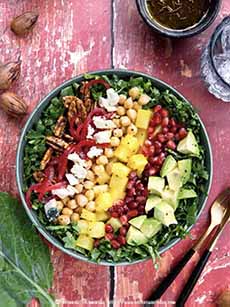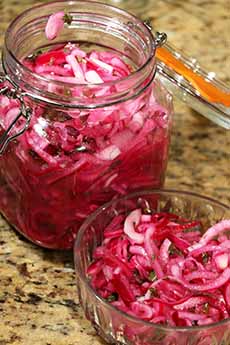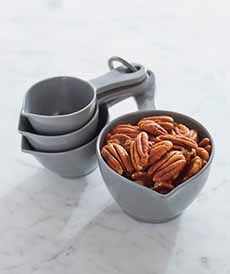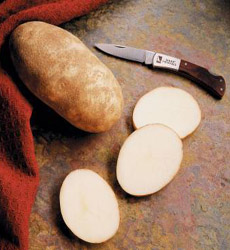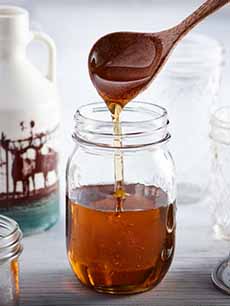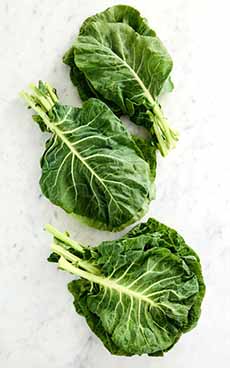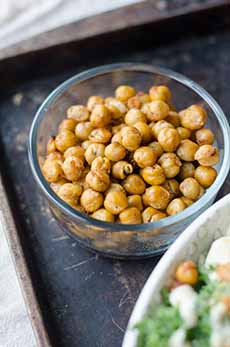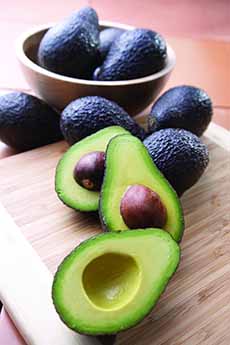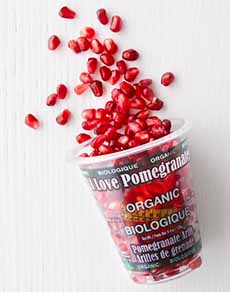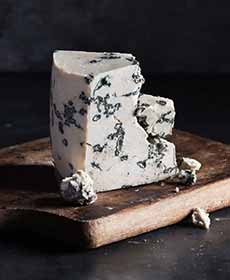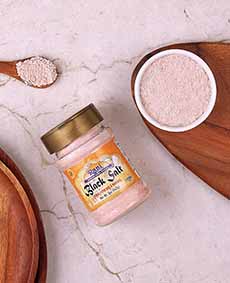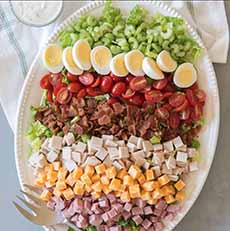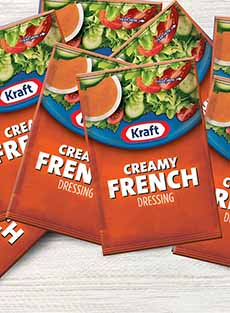Recipe For A Vegan Fall Cobb Salad, Delicious For Everyone
|
The Cobb salad was invented late one evening in 1937 when Bob Cobb, owner of The Brown Derby restaurant in Hollywood, was scrounging in the kitchen’s refrigerator for a snack. He grabbed a head of iceberg lettuce, an avocado, some romaine, watercress, tomatoes, a cold breast of chicken, a hard-cooked egg, chives, blue cheese and some old-fashioned French dressing. He took some crisp bacon from one of the chefs and started chopping. He laid each ingredient in a row, in a bowl. Cobb shared the salad with his friend Sid Grauman, proprietor of Grauman’s Chinese Theatre, who came back the next day and asked for a “Cobb Salad.” It was put on the menu and became an overnight sensation. Customers like movie mogul Jack Warner regularly dispatched his chauffeur to pick one up. > The recipe for vegan Cobb salad follows, below. > The history of the Cobb salad. > Salmagundi, the ancestor of Cobb salad and others. > A year of salad holidays is below. > More Cobb salad recipes are below. > The history of French and Catalina salad dressings, below. > November is World Vegan Month. > November 1st is National Vegan Day. Our colleague Hannah Kaminsky of Bittersweet Blog, adapted the Cobb salad for vegan diets, replacing the traditional proteins with plant-based alternatives that not only complement the dish but enhance it. Bob Cobb’s salad dressing was a basic vinaigrette with the added complexity of of mustard and lemon juice (no, it wasn’t blue cheese or ranch, which was then called buttermilk dressing). But rather than going traditional, Hannah goes autumnal with a maple-balsamic vinaigrette, adding sweetness to the acidity. It’s not easy to find smoked pecans, but it’s relatively easy to make them. Check out these reviews: The first three steps can be made a day or more in advance. 1. PICKLE the onions. Combine the red onion with red wine vinegar, granulated sugar, and salt in a small saucepan. Set over medium heat and stir until the sugar and salt are dissolved. Let the mixture sit for at least 15 minutes to cool. Ideally, prep this in advance and let it chill in the fridge for 30 minutes or longer. Drain before adding to the salad. 2. ROAST the pecans. Preheat the oven to 350°F. In small a bowl, mix together the pecan halves, soy sauce, olive oil, liquid smoke, and smoked paprika until well coated. Spread the pecans on a baking sheet and bake for 10-12 minutes, stirring halfway, until fragrant and slightly crispy. Allow to cool. 3. BOIL the potato. Place the diced potato in a small saucepan, adding water to cover. Add salt and boil until fork tender, 10-15 minutes. Drain and let cool. Toss the cooled dice with olive oil, kala namak, and turmeric. 4. MAKE the vinaigrette. In a small bowl, whisk together olive oil, maple syrup, balsamic vinegar, Dijon mustard, crushed rosemary, black pepper, and salt until emulsified. 5. ASSEMBLE the salad. Place the shredded collard greens in a large bowl, evenly filling the bottom. Arrange the pickled onions, bacon’d pecans, potato, chickpeas, avocado, pomegranate arils, and vegan blue cheese in straight rows on top. Serve the vinaigrette on the side, or drizzle liberally all over. The “French dressing” Americans know is a sweet, orange-red creamy dressing—and likely never graced the shores of France. It was invented in the U.S. The French use cruets of oil and vinegar, or an emulsified vinaigrette, on their salads: simply oil, vinegar, and seasonings. America’s “French dressing” was invented in the early 1900s in the U.S., although the exact inventor is lost to time. What we do know is that Kraft Foods began mass-producing a version in 1925, and another version, Milani’s 1890 French Dressing, was another early commercial version. The recipe combined oil and vinegar with sugar (or corn syrup), paprika, and other spices. The orange-red color and additional sweetness came from adding tomato ketchup or tomato puree. Our mother made it with a cruet and spice packet from Good Seasons, adding oil and vinegar and shaking the cruet until the dressing emulsified. The brand is now owned by the Kraft Heinz Company, and while they’ve discontinued French, they still have Italian, Mild Italian, Zesty Italian, Garlic & Herb, Greek, and the newer Balsamic. Catalina dressing is a variation of “French” that’s thinner and brighter red in color from a larger proportion of ketchup, which also delivers more pronounced tomato and spice flavors. It’s a blend of ketchup, vinegar, oil, and sugar plus spicy-sweet flavors from Worcestershire sauce, ground mustard, and a dash cayenne pepper. It also has a less creamy texture, and often includes onion and garlic flavors. Kraft Foods is credited with popularizing Catalina dressing in the 1950s, introduced as a variation of the very popular French dressing, Both French and Catalina are different from “Russian dressing,” a combination of ketchup, mayonnaise, and seasonings. Add pickle relish and you’ve got Thousand Island dressing. |
|
|
|
________________ CHECK OUT WHAT’S HAPPENING ON OUR HOME PAGE, THENIBBLE.COM. |
||
